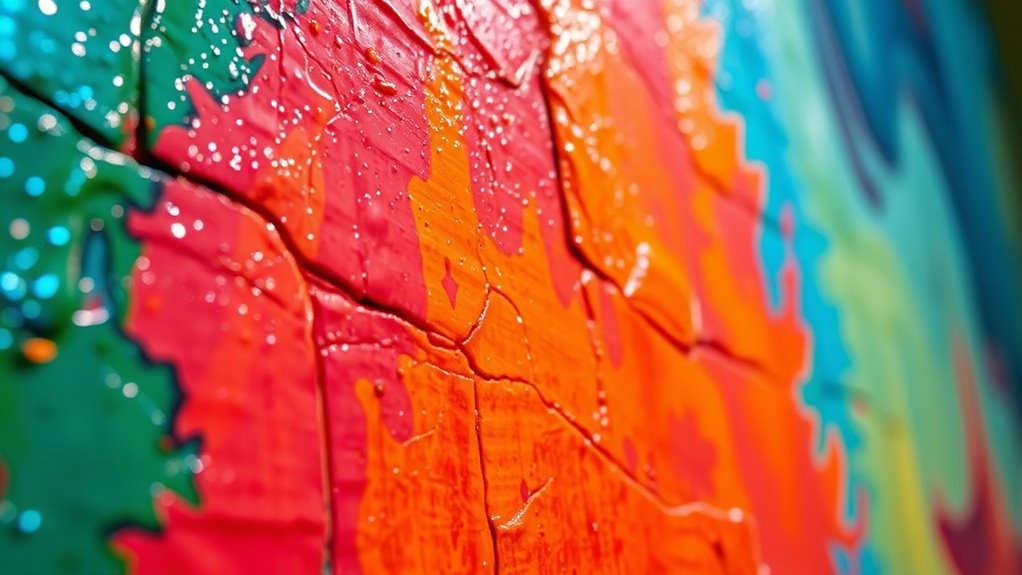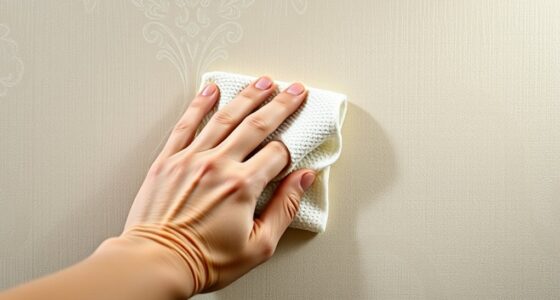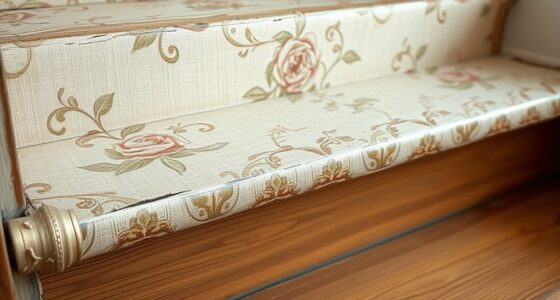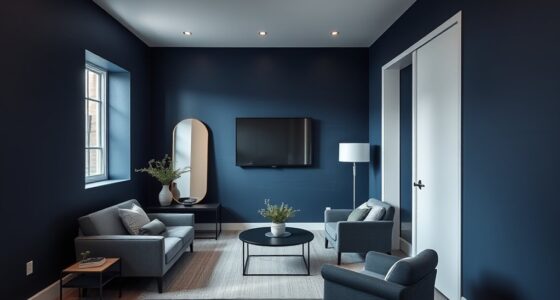UV light can cause artwork to fade and deteriorate by breaking down pigments and binders over time. To prevent this, use UV-filtering glass or acrylic in frames, keep artworks away from direct sunlight, and control artificial lighting in display areas. Regular inspections help identify early damage. For more effective preservation, explore advanced UV filtering materials and proper storage methods that can extend the life of your art.
Key Takeaways
- Use UV-filtering glass or acrylic in framing to block harmful rays.
- Keep artworks away from direct sunlight and high UV artificial lighting.
- Install UV protective films on windows in display areas.
- Regularly inspect artworks for early signs of fading or damage.
- Control ambient lighting and store artworks in dark, stable environments.
How UV Light Affects Artistic Materials
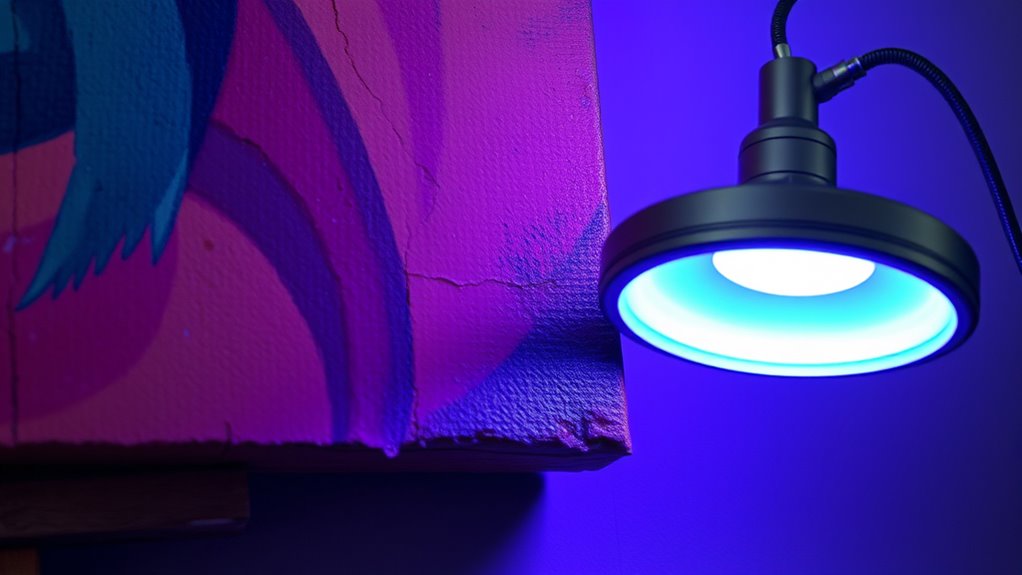
UV light can cause significant damage to artistic materials by breaking down chemical bonds in pigments, dyes, and binders. This damage occurs because the ultraviolet spectrum contains high-energy photons that penetrate surfaces and disrupt molecular structures. As a result, pigment deterioration accelerates, leading to fading and loss of vibrancy. Over time, exposure to UV rays weakens the stability of colors and materials, making artworks more fragile. You might notice subtle changes in hue or texture as the chemical integrity of the materials deteriorates. Protecting your artwork from UV exposure is essential to preserve its original appearance and longevity. Limiting UV exposure helps slow down chemical reactions that cause deterioration, ensuring your art remains vibrant and well-preserved for years to come. Additionally, understanding the impact of Photochemical Damage can help in choosing appropriate protective measures for artwork conservation, especially since UV-induced deterioration is a common concern among conservators. Implementing UV filters or protective glazing can significantly reduce the risk of material breakdown, safeguarding the artistic integrity over time. Research shows that AI-driven monitoring can further assist in detecting early signs of UV-related damage, allowing for timely interventions.
Recognizing Signs of UV-Induced Damage
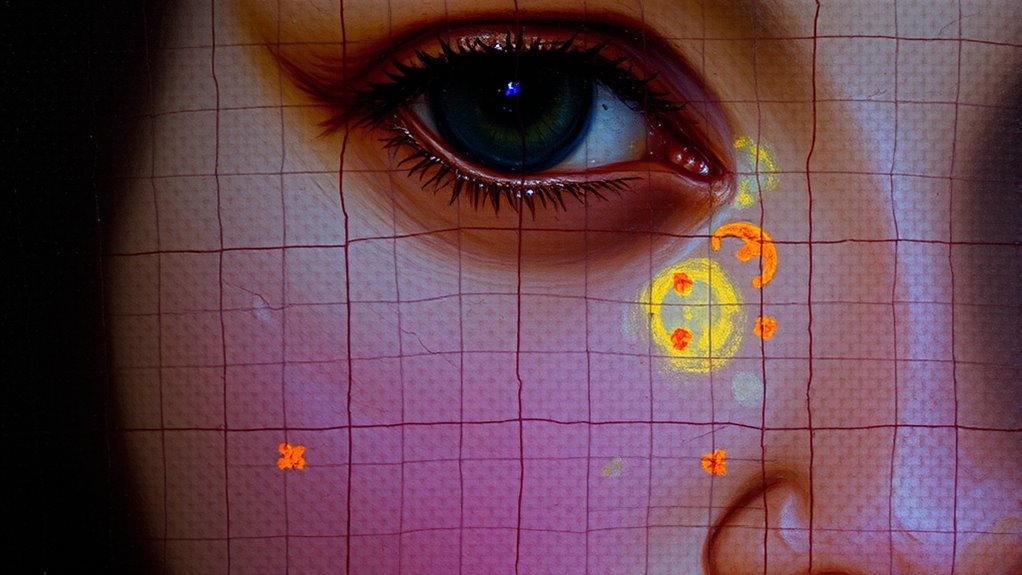
When artworks are exposed to ultraviolet light, signs of damage become increasingly visible, making it important to know what to look for. One key indicator is UV damage, which often manifests as uneven or gradual color fading. You might notice areas where the original hues have become dull or less vibrant, especially in sections exposed to more light. Over time, colors may appear washed out or considerably less intense. Cracks, surface bleaching, or a chalky appearance can also signal UV-induced deterioration. These changes often happen subtly at first, so regular inspection helps detect early damage. Recognizing these signs early allows you to take action before the damage becomes irreversible, preserving your artwork’s integrity and visual impact. Additionally, understanding the role of attention in monitoring artwork can improve your ability to notice minute changes that indicate UV damage. Incorporating preventive measures, such as proper lighting and display techniques, can significantly reduce the risk of UV-related harm. Being aware of UV exposure risks can further help in implementing effective protection strategies. Implementing UV filters on light sources is another effective way to protect artwork from harmful rays.
Protective Measures for Art Displays
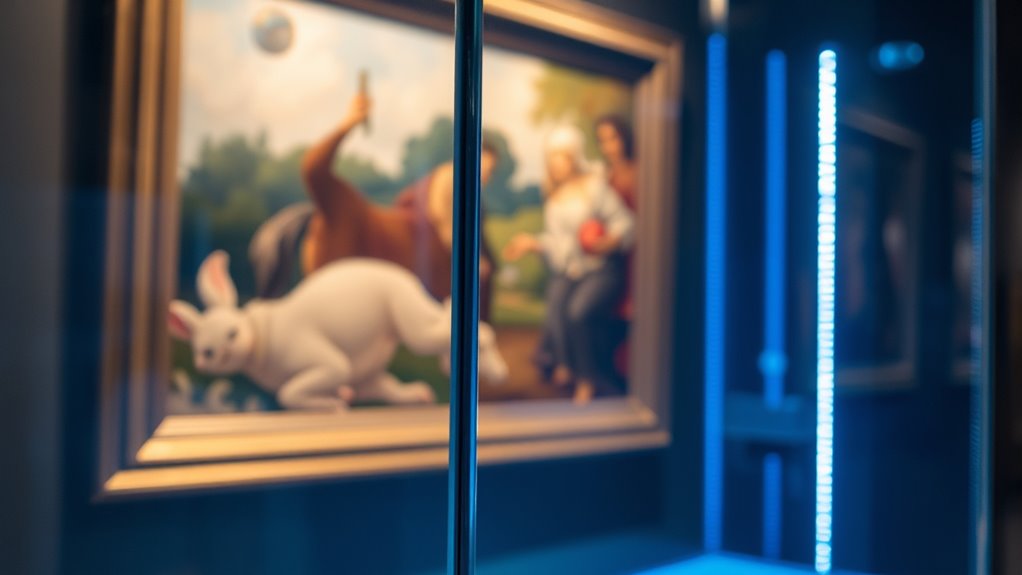
Are you looking for effective ways to protect your artwork from UV-related damage? The key is minimizing UV exposure during display and storage. Use UV-filtering glass or acrylic in frames to block harmful rays while allowing viewers to appreciate your art. Keep your pieces away from direct sunlight and bright artificial lights, especially those with high UV emissions. If you display artwork in well-lit areas, consider installing UV protective films or films on windows to reduce light damage over time. Controlling the lighting environment helps preserve colors and materials, preventing fading and deterioration. Regularly inspect your artworks for signs of light damage and adjust lighting arrangements accordingly. Incorporating UV protection measures can further enhance the preservation of your art. Ensuring proper lighting control also plays a crucial role in maintaining the integrity of your artwork over time. Taking these protective measures ensures your art remains vibrant and well-preserved for years to come.
Technologies and Materials for UV Filtering
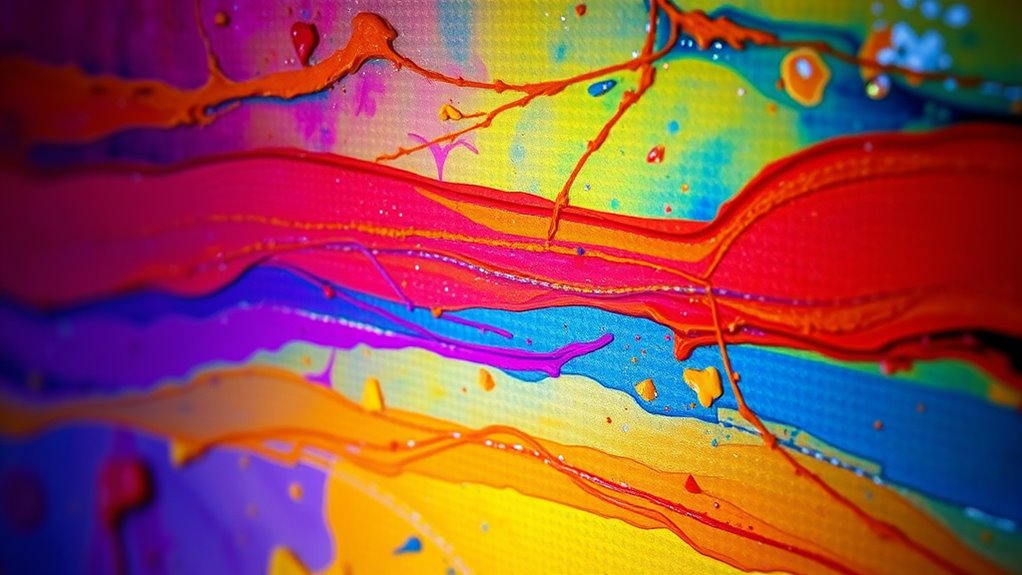
Advancements in materials and technologies have considerably improved how you protect artwork from light damage. Modern UV filtering solutions include specialized glass coatings that block harmful rays while maintaining clarity. These coatings can be applied to display cases or framing glass, reducing UV transmission effectively. Some coatings are designed with nano-technology, offering enhanced durability. Below is a comparison of common UV filtering options:
| Material Type | UV Blocking Effectiveness | Cost |
|---|---|---|
| Standard Glass Coatings | 70-90% UV reduction | Moderate |
| UV Filtering Films | Up to 99% UV reduction | Affordable |
| Laminated Glass | 95-100% UV blocking | Higher cost |
Choosing the right material guarantees your artwork remains vibrant over time.
Best Practices for Long-Term Art Preservation
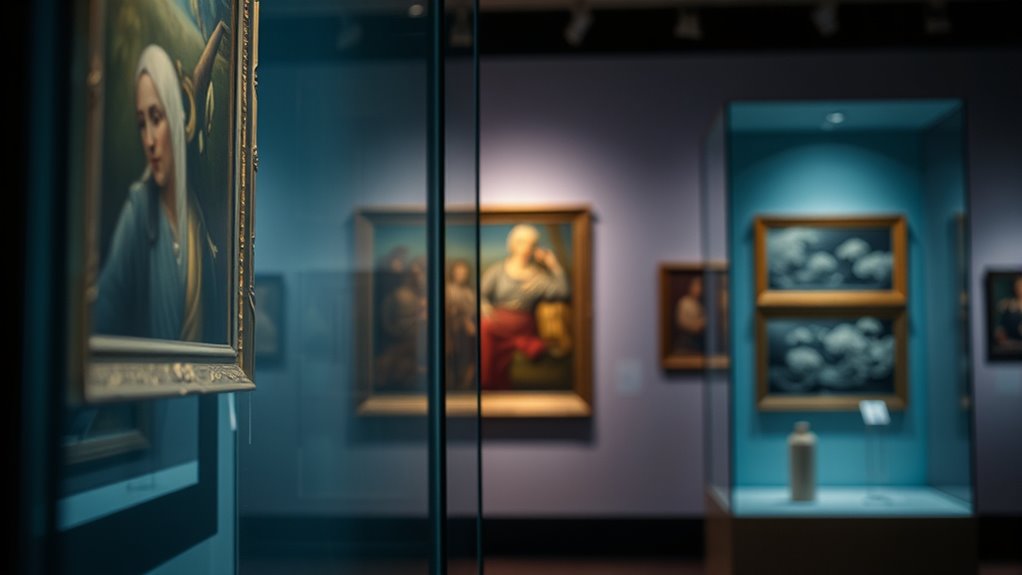
To guarantee your artwork endures over time, implementing consistent and careful preservation practices is essential. Minimize UV exposure by displaying your art away from direct sunlight and using UV-filtering glass or acrylic. Keep light sensitivity in mind; some pieces are more vulnerable to fading than others. Limit light exposure by controlling ambient lighting, and turn lights off when not viewing the artwork. Store pieces in dark, cool environments with stable temperature and humidity levels. Regularly inspect your collection for signs of damage or fading. Avoid frequent handling, and use gloves to prevent oils and dirt transfer. Proper storage conditions are crucial for preventing deterioration, and these routines help slow deterioration, preserve colors, and ensure your artwork remains vibrant and intact for years to come. Additionally, maintaining a consistent environmental control strategy can significantly extend the lifespan of your art collection. Incorporating air purification technology such as HEPA filters can further reduce airborne pollutants that may accelerate fading and deterioration. Furthermore, avoiding exposure to chemical pollutants in the environment can help protect your artwork from long-term damage.
Frequently Asked Questions
How Does UV Light Impact Different Types of Paint and Ink?
UV light accelerates paint degradation and ink fading by breaking down chemical bonds in different materials. You’ll notice colors dulling faster on paintings with oil or acrylic paints and inks on paper or fabric. UV rays cause pigments to lose vibrancy and weaken binding agents, making your artwork look older. To protect your pieces, limit UV exposure and use UV-filtering glass or coatings, helping to preserve their original brilliance longer.
Are There Specific Lighting Guidelines for Museums and Galleries?
Think of your gallery as a delicate garden; strict lighting standards are your sun, carefully balanced to nurture your treasures without causing harm. You should follow conservation guidelines that specify low UV emissions, gentle intensities, and controlled durations. By doing so, you protect your artworks from fading and deterioration, ensuring they flourish for generations. Regularly review these standards and adapt your lighting to preserve your collection’s timeless beauty.
Can UV Damage Be Reversed or Repaired in Artworks?
UV damage in artworks can’t be fully reversed, but you can repair it using specialized restoration techniques. Experts may use conservational methods like inpainting, varnish removal, or consolidants to stabilize and improve the piece’s appearance. While some damage is permanent, proper UV damage repair helps mitigate further deterioration. Protecting your artworks from future UV exposure is essential, so follow recommended lighting guidelines and avoid direct sunlight to preserve their integrity.
What Are the Latest Innovations in UV Protective Coatings?
You’ll find that the latest innovations in UV protective coatings include smart coatings and nano technologies. These advanced solutions actively respond to environmental changes to enhance protection, often adjusting transparency or UV-blocking properties as needed. Nano particles create a stronger, more durable barrier against UV rays, while smart coatings can adapt dynamically, offering superior fading prevention for artworks and sensitive materials. Embracing these innovations guarantees your pieces stay vibrant longer.
How Often Should UV Filters or Protective Measures Be Checked or Replaced?
You should check your UV filters or protective measures every 6 to 12 months, depending on their maintenance schedule and filter lifespan. Don’t wait until fading starts to worry—regular inspections reveal hidden wear and tear. As time passes, filters lose effectiveness, risking your artwork’s safety. Stay vigilant, replace or service them promptly, and keep your art protected from fading. The key is consistent care to preserve its vibrant life.
Conclusion
By understanding how UV light can silently steal the vibrancy from your artwork, you hold the power to protect it. Think of UV rays as the thief in the night—unseen but damaging. With the right precautions, like UV filters and careful display choices, you can keep your art alive and stunning for generations. Don’t let time’s shadow dim your masterpiece—act now and keep its beauty shining bright, a beacon against fading.
